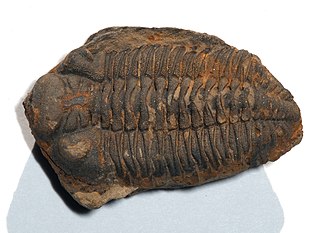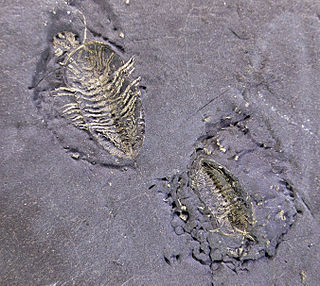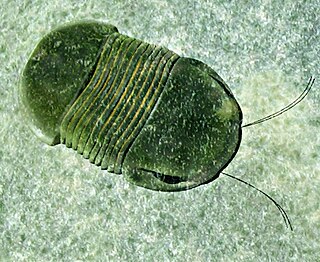Related Research Articles

Agnostida are an order of extinct arthropods which have classically been seen as a group of highly modified trilobites, though some recent research has doubted this placement. Regardless, they appear to be close relatives as part of the Artiopoda. They are present in the Lower Cambrian fossil record along with trilobites from the Redlichiida, Corynexochida, and Ptychopariida orders, and were highly diverse throughout the Cambrian. Agnostidan diversity severely declined during the Cambrian-Ordovician transition, and the last agnostidans went extinct in the Late Ordovician.

Trilobites are extinct marine arthropods that form the class Trilobita. Trilobites form one of the earliest known groups of arthropods. The first appearance of trilobites in the fossil record defines the base of the Atdabanian stage of the Early Cambrian period and they flourished throughout the lower Paleozoic before slipping into a long decline, when, during the Devonian, all trilobite orders except the Proetida died out. The last trilobites disappeared in the mass extinction at the end of the Permian about 251.9 million years ago. Trilobites were among the most successful of all early animals, existing in oceans for almost 270 million years, with over 22,000 species having been described.

Asaphida is a large, morphologically diverse order of trilobites found in marine strata dated from the Middle Cambrian until their extinction during the Silurian. Asaphida contains six superfamilies, but no suborders. Asaphids comprise some 20% of described fossil trilobites.

Phacopida ("lens-face") is an order of trilobites that lived from the Late Cambrian to the Late Devonian. It is made up of a morphologically diverse assemblage of taxa in three related suborders.

The Furongian is the fourth and final epoch and series of the Cambrian. It lasted from 497 to 485.4 million years ago. It succeeds the Miaolingian series of the Cambrian and precedes the Lower Ordovician Tremadocian Stage. It is subdivided into three stages: the Paibian, Jiangshanian and the unnamed 10th stage of the Cambrian.

Isotelus is a genus of asaphid trilobites from the Middle and Late Ordovician Period, fairly common in the northeastern United States, northwest Manitoba, southwestern Quebec and southeastern Ontario.

Arachnomorpha is a proposed subdivision or clade of Arthropoda, comprising the group formed by the trilobites and their close relatives (Artiopoda), Megacheira and chelicerates. Under this proposed classification scheme, Arachnomorpha is considered the sister group to Mandibulata.

Greenops is a mid-sized Devonian trilobite of the order Phacopida, subfamily Asteropyginae. They are mainly reported from the mid-Devonian Hamilton Group of upstate New York and southwestern Ontario. A similar-looking trilobite from Morocco is often mis-labelled Greenops. Greenops had schizocroidal eyes, large genal spines and short, sharp spines at the tip of each segment of the pygidium ("tail"). Greenops lived in warm, fairly deep water. In the Hamilton Group of New York, they are found with Eldredgeops, Dipleura and Bellacartwrightia, a trilobite that resembles Greenops but has much larger pygidial spines. In Ontario, they are found in the Widder Formation, which outcrops at Arkona, where they are, by far, the dominant trilobite.

Calymene Brongniart, 1822, is a genus of trilobites in the order Phacopida, suborder Calymenina, that are found throughout North America, North Africa, and Europe in primarily Silurian outcrops. Calymene is closely related to Flexicalymene, and both genera are frequently found enrolled. Calymene trilobites are small, typically 2 cm in length. The cephalon is the widest part of the animal and the thorax usually has 13 segments.

Calmoniidae is a family of trilobites from the order Phacopida, suborder Phacopina, superfamily Acastoidea.

Beecher's Trilobite Bed is a Konservat-Lagerstätte of Late Ordovician (Caradoc) age located within the Frankfort Shale in Cleveland's Glen, Oneida County, New York, USA. Only 3–4 centimeters thick, Beecher's Trilobite Bed has yielded numerous exceptionally preserved trilobites with the ventral anatomy and soft tissue intact, the soft tissue preserved by pyrite replacement. Pyritisation allows the use of X-rays to study fine detail of preserved soft body parts still within the host rock. Pyrite replacement of soft tissue is unusual in the fossil record; the only Lagerstätten thought to show such preservation were Beecher's Trilobite Bed, the Devonian Hunsrück Slates of Germany, and the Jurassic beds of La Voulte-sur-Rhône in France, although new locations are coming to light in New York state.
Bainella is an extinct genus of Devonian trilobites from off the coast of Gondwana. Fossils were found in the Ponta Grossa Formation of Brazil, Belén, Icla and Gamoneda Formations of Bolivia and the Gydo, Gamka and Voorstehoek Formations of South Africa. It contains three species: B. africana, B. baini, and B. cristagalli.

Encrinuroides is a genus of trilobites in the order Phacopida, that existed during the upper Ordovician in what is now Wales. It was described by Reed in 1931, and the type species is Encrinuroides sexcostata, which was originally described under the genus Cybele by Salter in 1848. It also contains the species, Encrinuroides enshiensis, Encrinuroides insularis, and Encrinuroides rarus. The type locality was in the Sholeshook Limestone Formation.
The Walcott–Rust quarry, in Herkimer County, New York, is an excellent example of an obrution Lagerstätte. Unique preservation of trilobite appendages resulted from early consolidation (cementation) of the surrounding rock, followed by spar filling of the interior cavity within the appendages. The presence of so many well preserved trilobites in one location alone qualifies the beds as an exceptional trilobite site, but the beds are further distinguished as the source of the first trilobites for which appendages were definitively described.
The cephalon is the head section of an arthropod. It is a tagma, i.e., a specialized grouping of arthropod segments. The word cephalon derives from the Greek κεφαλή (kephalē), meaning "head".
Micragnostus is a genus of trilobite in the order Agnostida, which existed in what is now north Wales. It was described by Howell in 1935, and the type species is Micragnostus calvus, which was originally described as a species of Agnostus by Lake in 1906.

Bumastus is an extinct genus of corynexochid trilobites which existed from the Early Ordovician period to the Late Silurian period. They were relatively large trilobites, reaching a length of 6 in (15 cm). They were distinctive for their highly globular, smooth-surfaced exoskeleton. They possessed well-developed, large compound eyes and were believed to have dwelled in shallow-water sediments in life.

Lopha is a genus of marine bivalve molluscs in the family Ostreidae.

Paleontology in Wisconsin refers to paleontological research occurring within or conducted by people from the U.S. state of Wisconsin. The state has fossils from the Precambrian, much of the Paleozoic, some a parts of the Mesozoic and the later part of the Cenozoic. Most of the Paleozoic rocks are marine in origin. Because of the thick blanket of Pleistocene glacial sediment that covers the rock strata in most of the state, Wisconsin’s fossil record is relatively sparse. In spite of this, certain Wisconsin paleontological occurrences provide exceptional insights concerning the history and diversity of life on Earth.

The Artiopoda is a grouping of extinct arthropods that includes trilobites and their close relatives. It was erected by Hou and Bergström in 1997 to encompass a wide diversity of arthropods that would traditionally have been assigned to the Trilobitomorpha. Trilobites, in part due to abundance of findings owing to their mineralized exoskeletons, are by far the best recorded, diverse, and long lived members of the clade. Other members, which lack mineralised exoskeletons, are known mostly from Cambrian deposits.
References
- ↑ Jell, P.A. and Adrain, J.M. (2002) Available Generic Names for Trilobites, Memoirs of the Queensland Museum 48(2), ISSN 0079-8835, page 341.